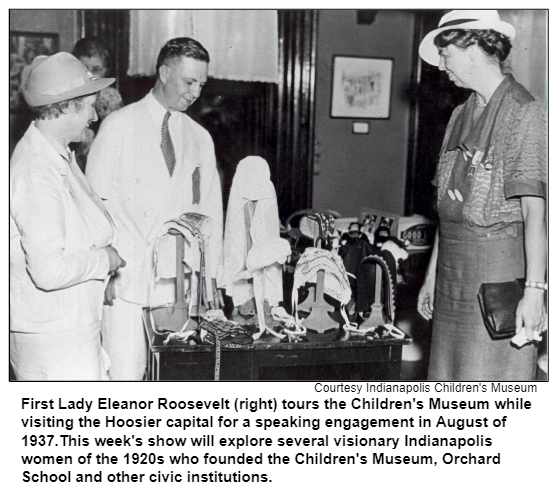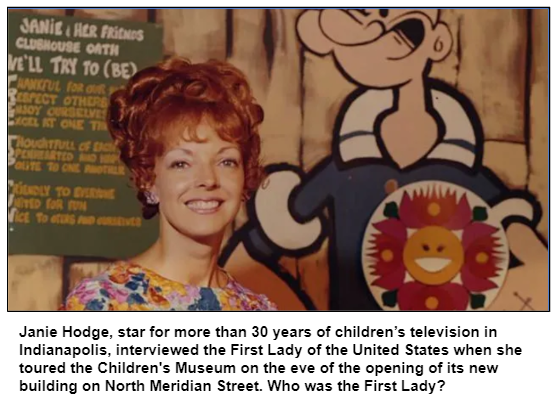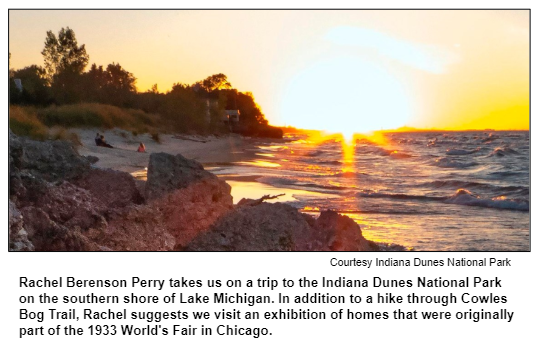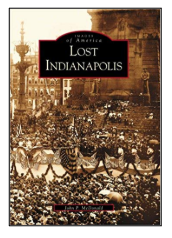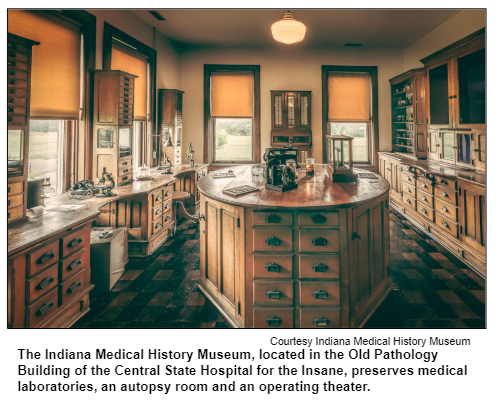
Saturdays, noon to 1 p.m. ET on WICR 88.7 FM.
Or listen live from anywhere on WICR Online!
Our call-in number during the show: (317) 788-3314
May 25, 2019
Influential women in 1920s: Their enduring vision for culture and children in Indy
For nine years beginning in 1980, Mark Kesling was director of science for the renowned Children's Museum of Indianapolis. From 1993 to 2006, Mark was the academic director at Orchard School, a private school on the northside of Indianapolis.
Not only did both institutions date back to the 1920s, Mark noticed, but they were initiated by the same group of visionary women.
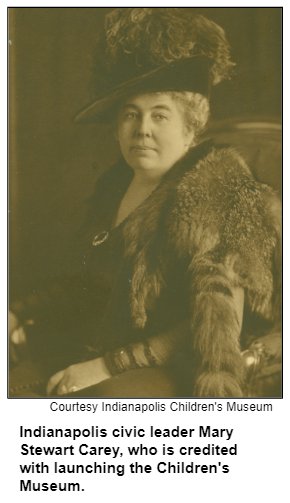
Mrs. Carey and several other women on the initial board of trustees of the Children's Museum also were members of the Progressive Education Association of Indianapolis. It met in 1922 to begin planning what became Orchard School, an elementary school (now K-8) founded to emphasize individualized instruction and learning through children's direct interactions with their environment.
To share details about these 1920s-era women civic leaders and their vision, Mark Kesling will be Nelson's studio guest.
Mark is the founder and CEO of The daVinci Pursuit, a non-profit organization that uses art to engage the community in science education opportunities. He also is the co-host, with Jill Ditmire, of She Says Art, He Says Science, the program on WICR-FM (88.7) that follows Hoosier History Live at 1 pm on Saturdays.
In addition to discussing the women civic leaders of the 1920s who helped launch the Children's Museum and Orchard School, Mark and Nelson will time-travel to 1916 to explore another cultural initiative of women that endures to this day. Inspired by the state's Centennial celebrations in 1916, women civic leaders initiated a contest to design the Indiana state flag. The winning entry, designed by Mooresville-based artist Paul Hadley, remains the state flag more than 100 years later.
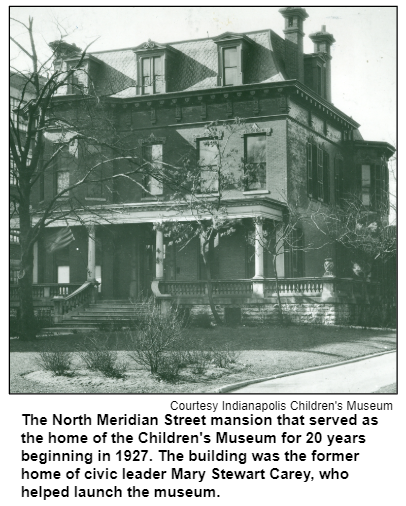
Mary Stewart Carey (1859-1938) was a member of the Daughters of the American Revolution and the Indianapolis Garden Club, both of which, at her initiative, were involved in the movement to adopt an Indiana state flag. Mrs. Carey, in fact, helped select the winning design.
For 20 years beginning in 1927, her former mansion at 1150 N. Meridian Street served as the home of the Children's Museum.
Orchard School, which began with 20 students, also was initially located in the large house of a founding family. During the 1950s, Orchard moved to its current site on about 43 wooded acres at 615 W. 64th Street.
Some history facts:
- Mrs. Carey's daughter, Mary Carey Appel, served on the first board of trustees of the Children's Museum. Mrs. Appel also was an organizer of the Progressive Education Association.
- Pulitzer Prize-winning novelist Booth Tarkington, author of The Magnificent Ambersons (1918) and Alice Adams (1921), was Mrs. Carey's first cousin.
- Orchard School's history is described in the book The Path Well Chosen (1984) by Caterina Cregor. The history of the Children's Museum is chronicled in Keep An Eye on That Mummy (1984) by Nancy Kriplen.
History Mystery
After several location changes early in its history, the Children's Museum of Indianapolis opened more than 40 years ago in a new facility at its current site at 3000 N. Meridian St. On the eve of the grand opening, the museum was visited by a First Lady of the United States.
Not only did she tour the new structure, which was touted as "state of the art," the First Lady even took a spin on the museum's antique carousel. She also was interviewed by Janie Hodge, the star of "Janie," a popular children's TV show; it had premiered during the early 1960s as "Popeye and Janie" on WTTV-Channel 4.
Question: Who was the First Lady who toured the Children's Museum the day before it opened in its current location?
Please do not call in to the show until you hear Nelson pose the question on the air, and please do not try to win if you have won any other prize on WICR during the last two months. You must be willing to give your first name to our engineer, you must answer the question correctly on the air and you must be willing to give your mailing address to our engineer so we can mail the prize pack to you. This week's prizes: a Family 4-Pack to Conner Prairie, including 4 tickets to the 1859 Balloon Voyage, courtesy of Conner Prairie.
Roadtrip: Indiana Dunes' Century of Progress District and Cowles Bog
Guest Roadtripper Rachel Berenson Perry of Brown County suggests a trip to the Indiana Dunes National Park on the southern shore of Lake Michigan. The 15,000 acre park was formerly called the Indiana Dunes National Lakeshore and is separate from the smaller Indiana Dunes State Park.
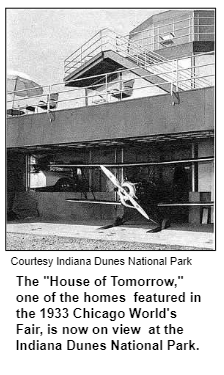
After the exposition ended in 1934, the homes were moved by barge to the town of Beverly Shores, now encompassed by Dunes parkland. The homes are in the process of being restored through a partnership between the National Park Service and Indiana Landmarks. Rachel tells us there is very informative interpretive signage at the location - or you can preview your visit by listening to a 2018 Hoosier History Live show exploring the homes' history and restoration process.
To balance out our visit to the area, Rachel recommends a side trip to Cowles Bog Trail, almost five miles of pathway that wends its way among ponds, marshes, swamps, black oak savannas and beaches, showing the natural beauty and ecological diversity of the area.
"There are boardwalks that traverse the marshes to gentle rolling hills and prairie land. At the end of the trail is a large dune. Once you get to the top, the expanse of Lake Michigan opens before you," Rachel says.
Sounds like a great end to a fantastic Roadtrip!
Nelson Price, host and historian
Molly Head, producer/project manager, (317) 927-9101
Michael Armbruster, associate producer
Cheryl Lamb, administrative manager
Richard Sullivan, senior tech consultant
Pam Fraizer, graphic designer
Garry Chilluffo, special events consultant
Please tell our sponsors that you appreciate their support!

 Acknowledgments to Monomedia, Visit Indy, WICR-FM, Fraizer Designs, Heritage Photo & Research Services, Henri Pensis, Aaron Duvall, Chloe Tyson, and many other individuals and organizations. We are independently produced and are self-supporting through organizational sponsorship and through individual contribution at the yellow button on our newsletter or website. For organizational sponsorship, which includes logos, links, and voiced credits in the show, contact Molly Head at (317) 927-9101 or email her at molly@hoosierhistorylive.org. Our media reach continues to grow via podcasting and iTunes.
Acknowledgments to Monomedia, Visit Indy, WICR-FM, Fraizer Designs, Heritage Photo & Research Services, Henri Pensis, Aaron Duvall, Chloe Tyson, and many other individuals and organizations. We are independently produced and are self-supporting through organizational sponsorship and through individual contribution at the yellow button on our newsletter or website. For organizational sponsorship, which includes logos, links, and voiced credits in the show, contact Molly Head at (317) 927-9101 or email her at molly@hoosierhistorylive.org. Our media reach continues to grow via podcasting and iTunes.
Thank you!
We'd like to thank the following recent, new and renewal contributors whose donations help make this show possible!
- Perry and Melanie Hammock
- Jim and Bonnie Carter
- Barbara and Michael Homoya
- Noraleen Young
- Barbara Wellnitz
- Phil and Pam Brooks
- Russ Pulliam
- Roz Wolen
- Marion Wolen
June 1, 2019 - coming up
From pathology building to medical history museum
During the 1890s on the Indianapolis campus of what was then called Central State Hospital for the Insane, brain research was undertaken in the brick building that came to be known as the Old Pathology Building.
The research - considered groundbreaking for its era - occurred in three clinical laboratories in the structure. It also had an autopsy room and an amphitheater where medical students learned about the brain as well as the treatment of syphilis and other diseases.
In 1969, more than 20 years before the closing of Central State as a psychiatric hospital, the Old Pathology Building - with most of its original furnishings, specimens, equipment and records - became the Indiana Medical History Museum.
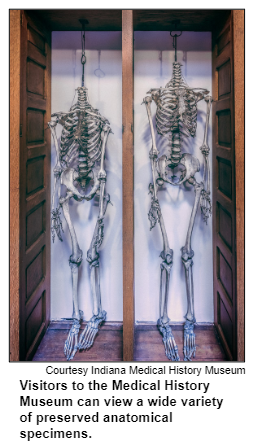
Now, as the museum described as a "hidden history gem" celebrates its 50th anniversary, major improvements have been initiated. In September, an Indiana Historical Bureau marker commemorating the Old Pathology Building will be erected on the site.
As we explore the captivating history that has unfolded in the pathology building-turned-museum - where jars of human brain tissue and historic medical equipment are displayed - Nelson will be joined in studio by:
- Sarah Halter, the museum's executive director since 2014. She is a board member and past president of the Association of Indiana Museums.
- And Norma Erickson, a board member of the museum and a medical historian. She was a Hoosier History Live guest in 2018 for a show about the history of African-American health care in Indianapolis.
Next to the museum, the former campus of Central State has become the site of apartments, single-family houses and businesses - both in historic and newly constructed buildings. Along with other state mental health hospitals, Central State was closed in 1994.
© 2019 Hoosier History Live. All rights reserved.
|
